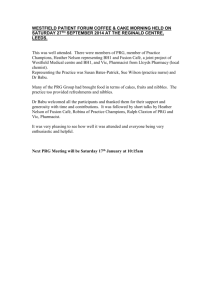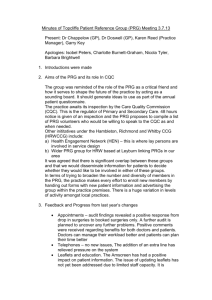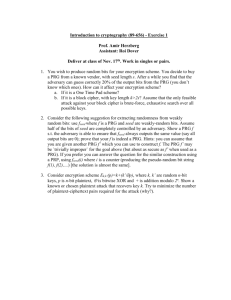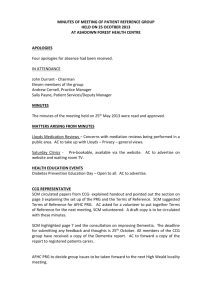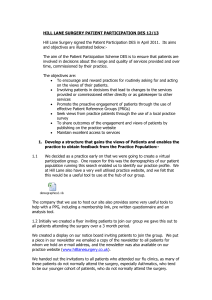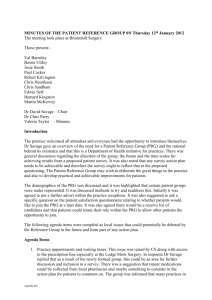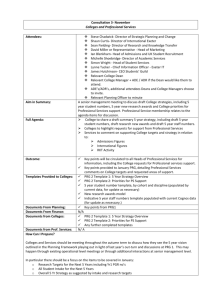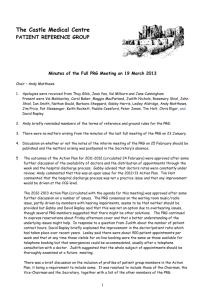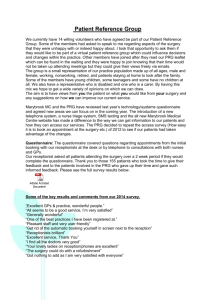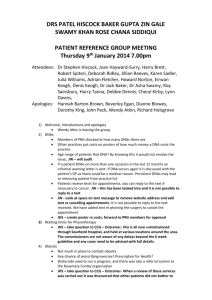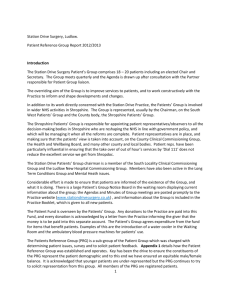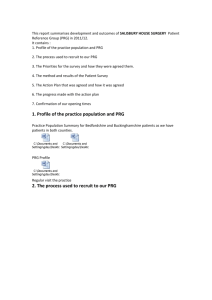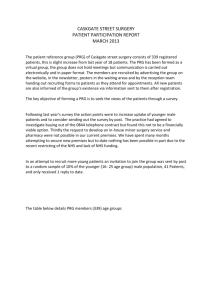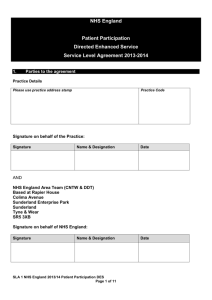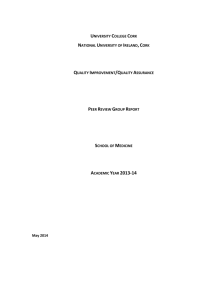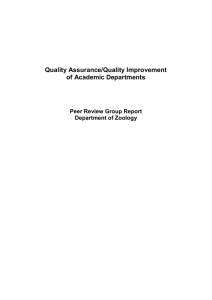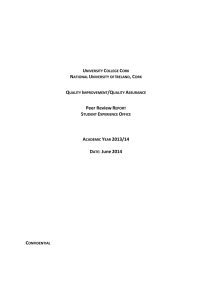Patient Reference Group Meeting Minutes 11.9.14
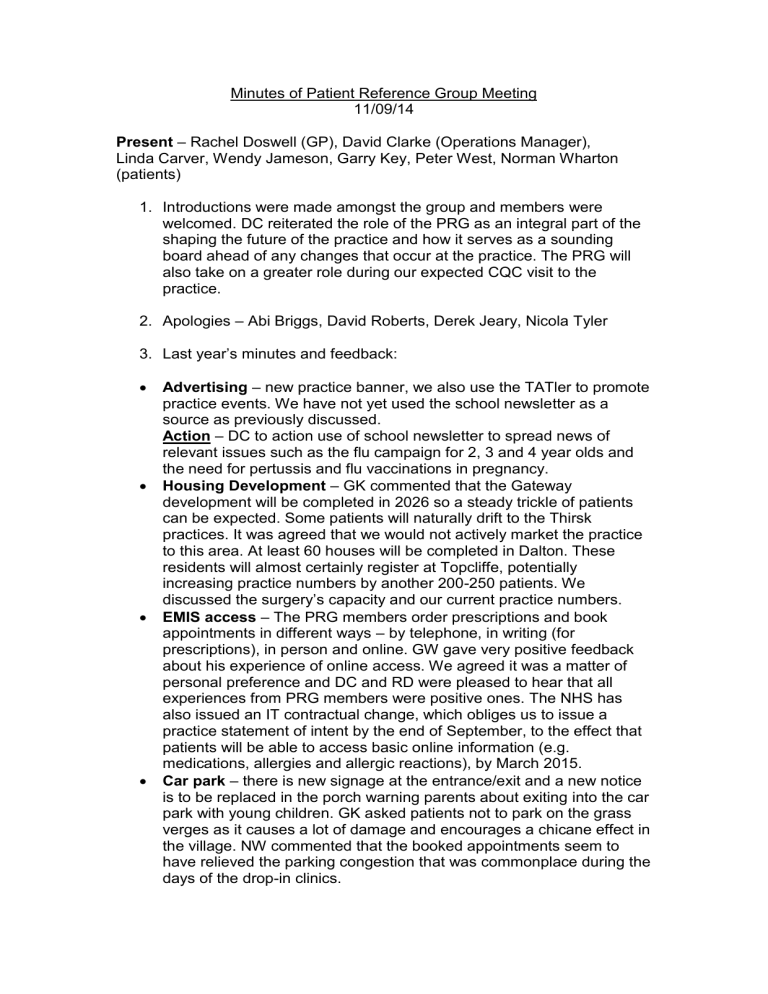
Minutes of Patient Reference Group Meeting
11/09/14
Present
– Rachel Doswell (GP), David Clarke (Operations Manager),
Linda Carver, Wendy Jameson, Garry Key, Peter West, Norman Wharton
(patients)
1. Introductions were made amongst the group and members were welcomed. DC reiterated the role of the PRG as an integral part of the shaping the future of the practice and how it serves as a sounding board ahead of any changes that occur at the practice. The PRG will also take on a greater role during our expected CQC visit to the practice.
2. Apologies
– Abi Briggs, David Roberts, Derek Jeary, Nicola Tyler
3. Last year’s minutes and feedback:
Advertising
– new practice banner, we also use the TATler to promote practice events. We have not yet used the school newsletter as a source as previously discussed.
Action
– DC to action use of school newsletter to spread news of relevant issues such as the flu campaign for 2, 3 and 4 year olds and the need for pertussis and flu vaccinations in pregnancy.
Housing Development – GK commented that the Gateway development will be completed in 2026 so a steady trickle of patients can be expected. Some patients will naturally drift to the Thirsk practices. It was agreed that we would not actively market the practice to this area. At least 60 houses will be completed in Dalton. These residents will almost certainly register at Topcliffe, potentially increasing practice numbers by another 200-250 patients. We discussed the surgery’s capacity and our current practice numbers.
EMIS access
– The PRG members order prescriptions and book appointments in different ways – by telephone, in writing (for prescriptions), in person and online. GW gave very positive feedback about his experience of online access. We agreed it was a matter of personal preference and DC and RD were pleased to hear that all experiences from PRG members were positive ones. The NHS has also issued an IT contractual change, which obliges us to issue a practice statement of intent by the end of September, to the effect that patients will be able to access basic online information (e.g. medications, allergies and allergic reactions), by March 2015.
Car park – there is new signage at the entrance/exit and a new notice is to be replaced in the porch warning parents about exiting into the car park with young children. GK asked patients not to park on the grass verges as it causes a lot of damage and encourages a chicane effect in the village. NW commented that the booked appointments seem to have relieved the parking congestion that was commonplace during the days of the drop-in clinics.
Action
– DC to replace notice in porch. DC to add a request in the next newsletter asking patients to park sensibly and not park on the verges.
Appointments – there were no negative comments about the changes to the nurses’ appointment system.
Repeat prescriptions – DC encouraged written requests for repeat prescriptions where possible as this reduces the possibility of errors being made.
NHS 111 – PRG reminded that this is a default for out of hours called.
Patient involvement in PRG – DC has attempted to invigorate the
PRG numbers. Despite advertising at the army barracks, it is difficult to engage young parents and patients who might provide a broader panel of opinions. Efforts continue to increase PRG numbers. Some members are happ y to be “virtual” and all opinions are valid and valued.
SOS Campaign
– the practice decided on balance not to support this
BMA campaign. However, it did go ahead with the “Put Patients First” campaign orchestrated by the RCGP. This involved asking patients to sign a petition urging the government to safeguard GP Practice income in the light of increasing patient demands. The petition secured a good number of signatures.
January 2014 meeting – due to workload commitments, matters which needed discussion were handled virtually, by email and post.
4. Surveys and proposed actions:
DC talked through the NHS survey along with the in-house practice survey. The areas to action were agreed as:
Level of privacy when speaking to a receptionist .
Action
– DC to action a note for reception along the lines of “Please allow the patient in front of you privacy when speaking to the receptionist”.
Nurse explained tests/treatments
Action
– RD/DC to speak to nurses about explaining tests and treatments to patients.
Level of satisfaction with the surgery’s opening hours . The surgery is open from 8am-6.30pm every weekday except Thursday when it is closed for processing automatic prescriptions, administration and training. We are also closed from 12.30-1.30pm. The practice leaflet clearly states that a doctor is on call for emergencies during these times. None of the PRG members present were aware of this fact. RD felt that this was the reason that this area was rated down in the survey.
Action
– DC to add a line in next TATler and newsletter stating that from 12.30-1.30 each day and on Thursdays from 12.30-6.30pm, a GP is on call for medical emergencies.
5. Practice nurses – end of walk-in clinics. See point 3 – no negative comments received. Better flow of traffic in car park.
6. Dispensary
– ordering repeat prescriptions and owed items.
Minutes of dispensary meeting discussed. All prescriptions aim to be fulfilled within 2 working days. New system in place so that any drugs that are owed to patients are now actively chased and an alternative supplier or an alternative drug can be sought.
7. Summary Care Records – DC and RD explained the information that will be uploaded onto the national spine
– drugs, allergies etc.
Differences to Care.data were explained.
8. Recorded Message. The current situation was explained – 2 lines into the practice plus one bypass line for outgoing calls. There is no point in more incoming lines as we have a limited number of staff to answer the telephones. Currently there is a pressure on receptionists to answer the phone promptly (sometimes at the expense of those waiting at the window). The aim of the proposed message is to ensure that a patient with a medical emergency is dealt with swiftly. The PRG agreed that the circulated content of the message is acceptable.
Action
– DC to take forward plans to proceed with message.
9. Newsletters – PRG members asked to sign up on the practice website for newsletters so that they will automatically be downloaded.
Action – DC agreed to email updated newsletters to all PRG members, or post to those who do not have internet access.
10. Practice News
Staff – News of Dr Sian Gilchrist’s return to the practice 3 sessions per week was warmly received by the PRG
Premises
– The schedule of refurbishments was discussed – new porch, redecoration, new carpets, boiler, patient toilet. WJ expressed concerns about a lack of fire exit downstairs. RD reassured her about fire safety.
Action – checked with Dr Parker after the meeting. Confirmed the building meets with fire regulations. The door between downstairs and upstairs is guaranteed fireproof for 2 hours. The windows in reception and dispensary open wide enough to allow alternative points of exit.
Keys to the upstairs windows are to be placed on a hook adjacent to each window in the event of a fire. In house risk assessments are up to date.
WJ raised an issue regarding the practice boundary and where the practice bins should be.
Action – The matter was taken forward by Dr Parker.
11. AOB
GK commented on the signs in the upstairs waiting room warning about “very hot radiator – do not touch”. We talked about this at a
recent practice meeting and are looking into a limiter valve to prevent patients from turning up the radiator.
PW asked whether the surgery had a position about the conflicting advice about the use of statins for all over 50’s. RD stated that all clinicians prescribe appropriately for secondary prevention of cardiovascular disease (i.e. for diabetics, those with heart disease or who have had a stroke). For primary prevention in the over 50’s we use a risk stratification tool, currently advising treatment with statins for all patients with a risk over 20%. New guidance recently issued by the
Royal College of GP’s suggests we should consider treating all those over 10%.
PW also asked about the awareness of patients about the CCG’s plans under the “Fit For The Future” banner and what the current austerity measures will mean for the practice? RD talked about the current state of play in that the CCG is in the process of gathering ideas about this.
The development of care models is the next phase with a public consultation to follow. This is when each of the CCG’s and the wider
NHS will publicise their strategies. A general discussion ensued about how the practice is always looking at ways in which to best serve the practice population. This may involve the clinicians looking at working in different ways, perhaps introducing regular telephone slots.
12. Date of next meeting – Jan/Feb 2015
